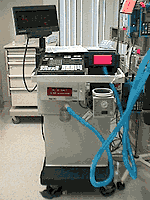Mechanical Ventilation
What is mechanical ventilation?
Mechanical ventilation is a form of artificial respiration that uses a breathing machine (mechanical ventilator) to assist patients with breathing. It is used when the lungs are not functioning properly.
How does the breathing machine (mechanical ventilator) work?
A breathing machine (mechanical ventilator) pushes air into the lungs. It includes controls to adjust the rate and size of each breath, a humidifier to warm and moisten the air going into the lungs, special tubing for the air to pass through, and a trap to collect unused moisture from the tubing. The breathing machine insures that adequate oxygen gets into the blood stream and carbon dioxide is exhaled.
Tubing, called breathing maching tubing or ventilator tubing, runs from the breathing machine to the breathing tube (endotracheal tube), which is inserted through the patient's mouth or nose. Sometimes the breathing machine tubing is connected to a tracheostomy tube. The breathing machine tubing, which is the larger "corrugated" tubing consists of two parts: one delivers the oxygen to be inhaled and the other part carries away the exhaled gas, including carbon dioxide. They meet at the junction with the breathing tube (endotracheal tube) or tracheostomy tube.
How long is a breathing machine used?
Usually a breathing machine is only used from few hours to a few weeks. Occasionally, a patient is required to use a breathing machine for much longer. Usage is determined by the doctor and is based on frequent assessments of the patient.
Does it hurt to be on the breathing machine?
No. The patient can feel air being pushed into the lungs, but it does not hurt.
Are there any potential complications associated with use of a breathing machine?
Patients who require breathing machine support are at increased risk to develop pneumonia. Occasionally, patients may develop a collapsed lung. Both of these complications require treatment.
Breathing machine (mechanical ventilator)

Breathing machine (mechanical ventilator)
